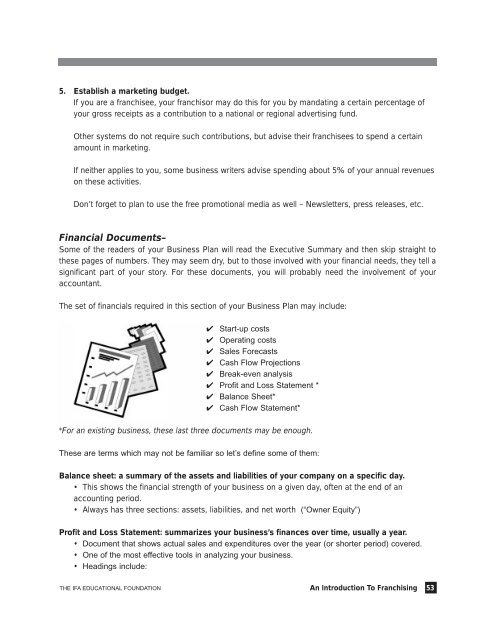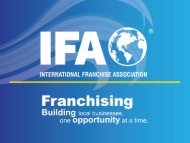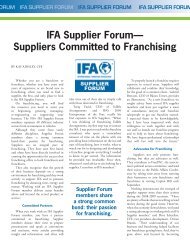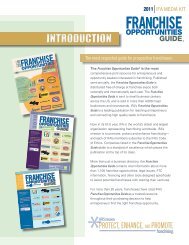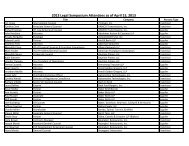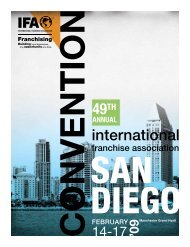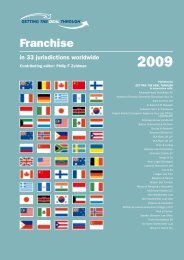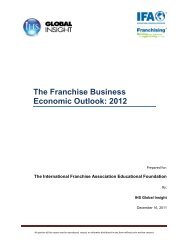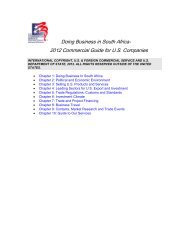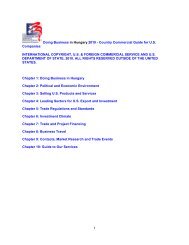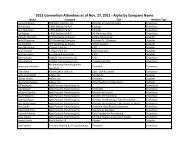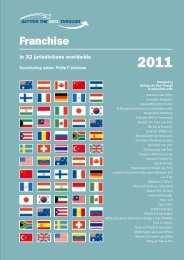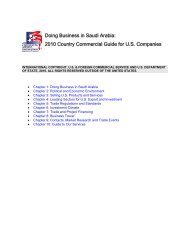Intro to Franchising IG - International Franchise Association
Intro to Franchising IG - International Franchise Association
Intro to Franchising IG - International Franchise Association
You also want an ePaper? Increase the reach of your titles
YUMPU automatically turns print PDFs into web optimized ePapers that Google loves.
5. Establish a marketing budget.<br />
If you are a franchisee, your franchisor may do this for you by mandating a certain percentage of<br />
your gross receipts as a contribution <strong>to</strong> a national or regional advertising fund.<br />
Other systems do not require such contributions, but advise their franchisees <strong>to</strong> spend a certain<br />
amount in marketing.<br />
If neither applies <strong>to</strong> you, some business writers advise spending about 5% of your annual revenues<br />
on these activities.<br />
Don’t forget <strong>to</strong> plan <strong>to</strong> use the free promotional media as well – Newsletters, press releases, etc.<br />
Financial Documents–<br />
Some of the readers of your Business Plan will read the Executive Summary and then skip straight <strong>to</strong><br />
these pages of numbers. They may seem dry, but <strong>to</strong> those involved with your financial needs, they tell a<br />
significant part of your s<strong>to</strong>ry. For these documents, you will probably need the involvement of your<br />
accountant.<br />
The set of financials required in this section of your Business Plan may include:<br />
THE IFA EDUCATIONAL FOUNDATION<br />
✔ Start-up costs<br />
✔ Operating costs<br />
✔ Sales Forecasts<br />
✔ Cash Flow Projections<br />
✔ Break-even analysis<br />
✔ Profit and Loss Statement *<br />
✔ Balance Sheet*<br />
✔ Cash Flow Statement*<br />
*For an existing business, these last three documents may be enough.<br />
These are terms which may not be familiar so let’s define some of them:<br />
Balance sheet: a summary of the assets and liabilities of your company on a specific day.<br />
• This shows the financial strength of your business on a given day, often at the end of an<br />
accounting period.<br />
• Always has three sections: assets, liabilities, and net worth (“Owner Equity”)<br />
Profit and Loss Statement: summarizes your business’s finances over time, usually a year.<br />
• Document that shows actual sales and expenditures over the year (or shorter period) covered.<br />
• One of the most effective <strong>to</strong>ols in analyzing your business.<br />
• Headings include:<br />
An <strong>Intro</strong>duction To <strong>Franchising</strong> 53


